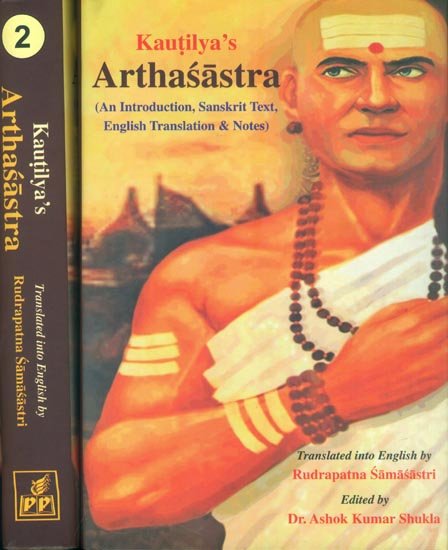Kautilya Arthashastra
by R. Shamasastry | 1956 | 174,809 words | ISBN-13: 9788171106417
The English translation of Arthashastra, which ascribes itself to the famous Brahman Kautilya (also named Vishnugupta and Chanakya) and dates from the period 321-296 B.C. The topics of the text include internal and foreign affairs, civil, military, commercial, fiscal, judicial, tables of weights, measures of length and divisions of time. Original ...
Preface to the Second Edition
It is nearly three years since copies of the first edition of this work have gone out of print, and demand for the book has been on the increase. Meanwhile a second edition of the text, based upon two more manuscripts seemed from the Oriental Manuscripts Library at Madras, has been published by me in the Oriental Library Sanskrit Series of the University of Mysore. A word-index has also since been prepared, and is now in the press. All along it has been my earnest endeavour to revise my translation with the aid of two more commentaries on the work since discovered. One of them is Nayacandrikā by Mādhavayajvan, and the other a translation, or rather paraphrase, by an unknown author, in a mixture of Tāmil and Malayālam languages. Unfortunately, both of them are as incomplete as Bhaṭṭasvāmi’s commentary. The first extends from the seventh chapter of the Seventh Book to the end of the third chapter of the Twelfth Book. It is neither a word-by-word commentary like Bhatṭasvāmi’s nor a paraphrase like the Tāmil-Malayālam commentary. Mādhavayajvan, its author, satisfies himself by supplying some connecting links between successive chapters and successive paragraphs in each chapter. The Tāmil-Malayālam paraphrase is, on the other hand, very copious, but omits to notice obscure passages here and there. It extends from the beginning to the end of the Seventh Book. Written as it is in a mixture of dialects, it is not very easy to understand it. It seems to be quite recent and is not free from misinterpretation of a few words. The word “Pravahaṇa,” for example, is taken to mean a drinking bout instead of a shipping company. There is, however, no doubt that, as they cover almost the whole of the text, when put together, they will be of great help in clearing obscurities with which the text abounds. Under these circumstances it will be a great boon to the readers of the Arthaśāstra if Mahāmahopādhyāya T. Gaṇapati Śāstri, Curator of the Oriental Library in Trivandram, publishes the long-advertised Sanskrit commentary, which he is said to have been writing with the aid of the three commentaries. As I could not get in time a copy of the Tāmil-Malayālam commentary on the first two Books, the most important portion of the work, and as demand for the translation was on the increase, I had to hurry on the second edition without comparing my own translation with that of the Tāmil Commentator.
A word on my recent interpretation of the word “Vyuṣṭa” used in the Arthaśāstra[1] seems to be necessary, inasmuch as it throws a great deal of light on the obscure Vedic hymns on the Uṣas (dawn). The word Vyuṣṭa, synonymous with Vyuṣṭi, Vyuṣa, Uṣas, and cognate with Vyaucchat, seems to signify a new year’s day, but not an ordinary dawn, as usually interpreted. The Vārāha Śrauta Sūtra[2] divides the night into four parts, and calls them (1) pradoṣa, (2) niśi, (3) upavyuṣa,[3] and (4) Vyuṣṭa.[4] The literal meaning of the word Vyuṣṭa is “lighted” or “dawned.” The Vedic people seem to have called the fourth division of the night, light or dawn (uṣas or vyuṣṭa), when early sunrise during the midsummer drove out darkness an hour or two earlier than usual; and nakta, when darkness lingered longer in winter. They seem to have also called the five longest days of midsummer Vyuṣṭis, and the sixth day Vyuṣṭa or Uṣas, as recognised by their length. There can be no doubt that during the time of Cāṇakya, Vyuṣṭa, the new year’s day, began with the first lunar day of the white half of Śrāvaṇa (July-August), and the year ended with the new moon of Āṣāḍha.[5]
In my paper on “Vyuṣṭa, the Vedic New Year’s Day,” read by me in the Second Oriental Conference in Calcutta, I have discussed the question at length, citing necessary authorities, the repetition of which is, I think, out of place here.
Attention may also be drawn to my preface in Sanskrit to the second edition of the text, in which I have extracted some stories from the sacred books of the Jainas illustrative of the meaning of some enigmatic passages at the close of Chapter V, Book V.
I have much pleasure in expressing my thankfulness to Mr. Thos. Gould, Superintendent of the Wesleyan Mission Press, for the neat get-up and quick despatch of the work; and to Mr. A. R. Krishnasasm, m.a., Kannada Specialist, and Mr. K. Rangasvami Iyengar, First Pandit, and Librarian of the Oriental Library, Mysore, for going through the proofs.
R. Shamasastry.
Mysore,
10 th July, 1923.
Footnotes and references:
[1]:
Text, p. 60, line 19; p. 64, lines 16,17,19.
[2]:
Ākulapāda Khaṇḍa, III.
[3]:
See Tait. Brah. I, 5, 2.
[4]:
See Kāṭhaka, S. 34, 17.
[5]:
P. 63, line 8; p. 64, line
